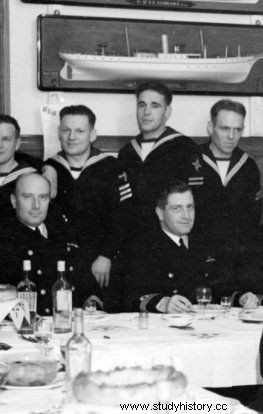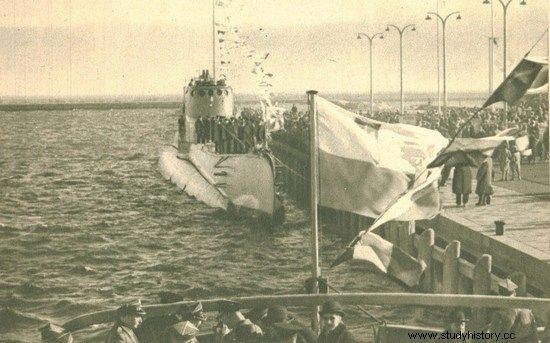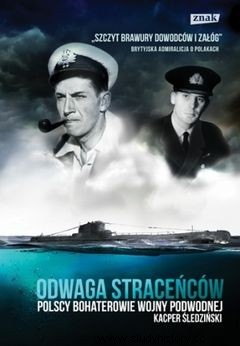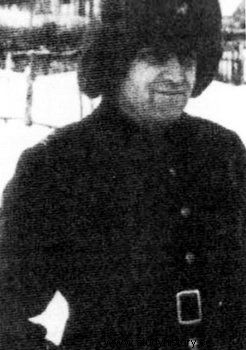When a submarine's captain desertions, the matter must be heard widely. The betrayal of the commander of ORP Orzeł - the most famous submarine in Polish history - to this day ignites emotions and causes fierce discussions. How was it really?
Lieutenant Commander Henryk Kłoczkowski was considered the best submarine in the Polish Navy before the war. No wonder, then, that he was chosen to be the captain of ORP Orzeł - the pride of the underwater fleet of the Second Polish Republic. When the commander took command of the unit, no one expected him to stain the officer's honor by arbitrarily leaving his post.
Bad even worse beginnings
The first signals that Henryk Kłoczkowski is not being properly committed to the duties entrusted to him appeared in the spring of 1939, i.e. for a good few months before the September campaign. With time it was only worse, and finally, on the eve of the outbreak of the war - despite the extremely tense situation on the Warsaw-Berlin line - the commander disembarked, granting passes to some of the crew.

When Henryk Kłoczkowski (sitting second on the left) became the captain of the Eagle, nothing indicated that he would stain the honor of the submarine.
As a result, when the Germans attacked Poland, he was not at Orle at all . He reached the port only on September 1 at 6.30, when OORP Ryś, Sęp, Wilk and Żbik had long gone to sea.
The situation did not improve at all after the ship under his command went to fight the Kriegsmarine. On the contrary, successive reports of German successes had an increasingly depressing effect on Kłoczkowski.
On the second day of the war, after the meeting of the Eagle and the Wolf at sea, the captain of the latter, Bogusław Krawczyk, aptly noticed that the moral side of Kłoczo was useless. The commander of the Eagle was discouraged, indignant, he spoke of a pointless war - that is, that he betrayed a clear floor .
The turning point turned out to be the afternoon of September 4, when the Eagle was attacked by a German plane. Despite being immediately submerged and descending to 70 meters, one of the dropped depth charges exploded dangerously close to the ship, causing some minor crashes on board.
It was worse with the commander. The raid had a very negative impact on his morale. Without permission from his superiors, he decided it was time to steer the ship further north, into the Gotland region.
The change of the reservoir did not have a calming effect on the nerves of Commander Kłoczkowski, who on September 8 began to unexpectedly complain about mysterious health problems. As he writes in his latest book, "Courage of the losers. Polish heroes of the submarine war ”Kacper Śledziński typhus or appendicitis was suspected.

Celebration of the Eagle in Gdynia on February 10, 1939. At that time, Commander Henryk Kłoczkowski was applauded. A few months later he could not stand the stress and defected.
However, a rumor quickly spread among the crew that the commander had in fact collapsed nervously and was only looking for an excuse to go ashore. Meanwhile, Rear Admiral Józef Unrug, having learned about the whole matter, made a clear decision: Either drop the commander in a neutral port and continue under the command of the deputy commander, or cautiously come to Hel at night to change the commander .
Kłoczkowski was by no means going to make his way towards the Polish coast, so after hesitating for four days, finally decided that it was time to move towards a safe harbor. The choice was quite unexpected. It fell on distant Tallinn. The knowledge of the local port and his contacts from the time of his studies at the St.Petersburg Sea Cadet School were probably decisive.

Henryk Kłoczkowski's desertion
The ship reached its destination on Thursday, September 14 at 21.30. Estonians were not, however, delighted with the unexpected appearance of Poles. They agreed to allow the vessel to enter the port, and even started repairing the damaged compressor, but in fact they had completely different plans for the ship.
That same night, a motorboat with sailors approached the ship's side, mooring on the roadstead of the Eagle. The Estonians started jumping onto the ship's ballasts without warning, probably wanting to intern the crew. Kłoczkowski, this one (the only one?) Reacted properly once:he ordered to move forward, as a result of which the Estonians had an unplanned bath in the cold Baltic Sea.
After catching them, the commander had a long conversation with the Estonian officer. Unfortunately, it is not known what it was about, but it had a decisive influence on the further fate of the Eagle commander. A few hours later, a boat unexpectedly approached the ship's side, and Henryk Kłokczowski boarded - again without informing his superiors or subordinates -.
On this occasion he took two large suitcases, a typewriter and a hunting fusion . He found his dream, quiet asylum in a Tallinn hospital. It was clear to the sailors that the commander did not intend to return to the ship and that he left his people at the mercy of the Estonians.

Commander Kłoczkowski's decision to disembark the Eagle divided the ship's crew and had a negative impact on their morale. In the photo, the Eagle is moored in a British port.
Fortunately, the Eagle's first officer, Captain Jan Grudziński, rose to the occasion. Thanks to his ingenuity and the bravado of the rest of the crew, the ship managed to escape Tallinn, and without maps or weapons, on October 14, 1939, the ship finally reached the shores of Scotland.
Naturally, the issue of the commander's desertion was widely discussed among the officers and sailors of not only the Eagle, but also the Wolf - the second unit to break through to Great Britain. It also had a huge impact on the morale of both crews. As noted by Kacper Śledziński:

Komandor Kłoczkowski in the photo probably taken in 1942
The news of Henryk Kłoczkowski's betrayal outraged the officers. Lieutenant Romanowski was the most staunch defender of the commander. He did not realize that Henryk Kłoczkowski, "a man of strict rules, a great patriot, would betray".
In the end, the whole thing ended almost three years later, when Commander Kłoczkowski finally - after he left the USSR with Anders' army - came to London. On June 17, 1942, the Naval Martial Court ruled that the captain of the Eagle had deserted. In this situation, there could only be one sentence.
Declared demotion to the rank of seaman and expulsion of the accused Lieutenant Commander Kłoczkowski, Henryk from the Navy . Additionally, the seaman Kłoczkowski was sentenced to four years in prison, but this part of the sentence was never carried out.
Source:
Trivia is the essence of our website. Short materials devoted to interesting anecdotes, surprising details from the past, strange news from the old press. Reading that will take you no more than 3 minutes, based on single sources. This particular material is based on:
- Kacper Śledziński, Courage of despair. Polish heroes of the submarine war , SIW Znak 2013.
